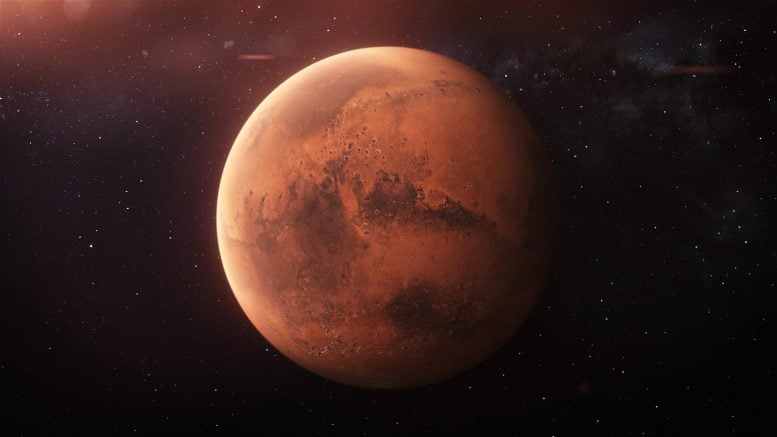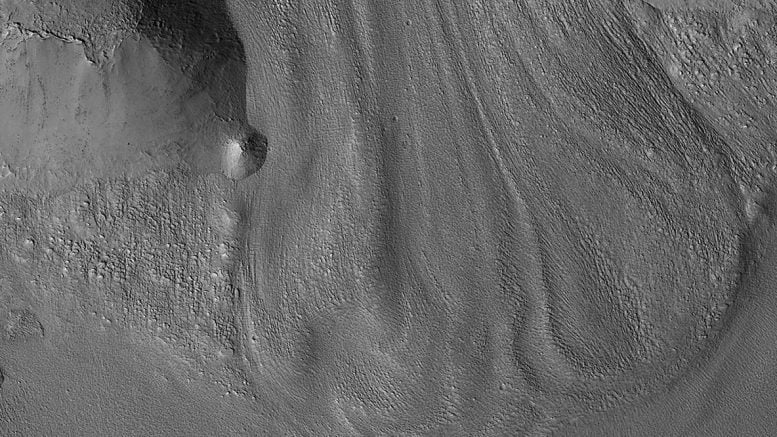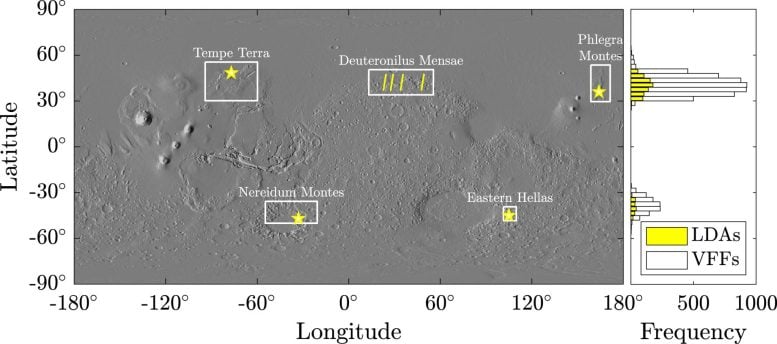
Mars’ glaciers are over 80% pure ice, formed by similar processes worldwide. This discovery sheds light on past climate and future exploration resources.
On the slopes of Martian mountains and within its craters lie formations that look like streams of honey, blanketed in dust and frozen in place. These structures are, in fact, glaciers that creep forward at an almost imperceptible pace. For years, scientists believed they were largely composed of rock with only limited amounts of ice mixed in.
Research carried out over the past two decades has shown that some of these glaciers are actually made up of mostly ice, with just a thin surface layer of dust and rock. Now, a new study published in Icarus reveals that this is not limited to a few sites—glaciers across Mars contain more than 80% water ice. This discovery indicates that the planet’s glacial deposits are remarkably pure on a global scale, offering fresh insight into Mars’ climate history and pointing to a potential resource for future exploration.
The study was led by Yuval Steinberg, a recent graduate of the Weizmann Institute of Science in Israel. His coauthors, Oded Aharonson and Isaac Smith, are senior scientists at the Planetary Science Institute in Tucson, with academic affiliations at the Weizmann Institute of Science and York University, respectively.
“This study highlights how NASA programs are advancing science not just within the United States, but also reaching students around the world,” Aharonson said.
Peering under the dust-covered veil

As the researchers reviewed earlier studies, they realized that the analysis of debris-covered glaciers had been inconsistent and difficult to compare.
“Different techniques had been applied by researchers to various sites, and the results could not be easily compared,” explained Smith. “One of the sites in our study had never been studied, and at two of the five sites we used, only partial analysis had been completed previously.”
To address this, the team developed a standardized approach for examining debris-covered glaciers. They focused on two key measurements: the dielectric property (which reflects how quickly radar waves travel through a material) and the loss tangent (which indicates how much of that energy is absorbed by the material). These values make it possible to estimate the ratio of ice to rock within a glacier—something that cannot be determined through surface observation alone, since dust and rock often obscure what lies beneath.
Global comparison of Martian glaciers
They also identified another area on Mars where SHARAD, short for the SHAllow RADar instrument onboard the Mars Reconnaissance Orbiter, could also do these analyses. This gave them a total of five sites spread across the red planet, enabling global comparison.

They were surprised to find that all glaciers, even in opposite hemispheres, have nearly the same properties.
“This is important because it tells us that the formation and preservation mechanisms are probably the same everywhere,” Smith said. “From that, we can conclude that Mars experienced either one widespread glaciation or multiple glaciations that had similar properties. And, by bringing together these sites and techniques for the first time, we were able to unify our understanding of these types of glaciers.”
Knowing the minimum purity of these glaciers benefits scientific understanding of the processes that form and preserve them. Additionally, it helps when planning for future human exploration of Mars, when using local resources, such as water, becomes mission-critical.
Next, the team will seek out additional glaciers to add their global comparison and solidify their understanding of these dust-covered mysteries.
Reference: “Physical properties of subsurface water ice deposits in Mars’s Mid-Latitudes from the shallow radar” by Yuval Steinberg, Isaac B. Smith and Oded Aharonson, 7 July 2025, Icarus.
DOI: 10.1016/j.icarus.2025.116716
Never miss a breakthrough: Join the SciTechDaily newsletter.
2 Comments
It’s also far more deadly, but that won’t deter that idiot Elon from trying to get there, either.
Don’t worry. Elon will use his Boring company to go there.